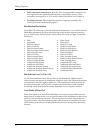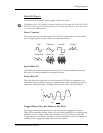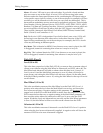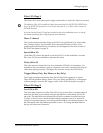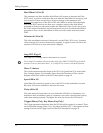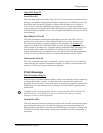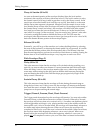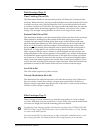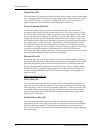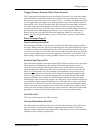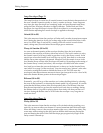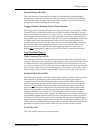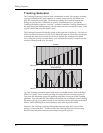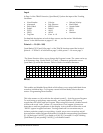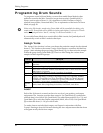
Editing Programs
QuadraSynth Reference Manual 77
Pitch Envelope (Page 3)
Time Tracking (On or Off)
This determines whether or not keyboard position will affect the cycle speed of the
envelope. When turned on, playing toward the higher end of the keyboard will result
in a faster envelope cycle; playing toward the lower end of the keyboard will result
in a slower envelope cycle. However, this does not effect the attack time, but only the
decay, sustain decay and release segments. This feature will result in only a subtle
change. The envelopeÕs timing doubles or halves over a range of two octaves.
Sustain Pedal (On or Off)
This determines whether or not the Sustain Pedal will have an effect on the envelope.
When turned on, holding down the Sustain Pedal while playing short notes is
virtually the equivalent to holding down those notes on the keyboard with some
subtle but important differences. If the Delay and Attack are set to 0 and either the
Decay is 0 or the Sustain is 99, the envelope will immediately jump to the sustain
decay stage (if not already there) when the note is released and the sustain pedal is
held down. If a long attack is set, and the envelope does not reach the end of the
attack segment when the note is released, it will be skipped and the envelope will
jump immediately to the release segment. If a long delay is set, and the envelope has
not reached the attack segment before the note is released, the envelope will remain
at 0. However, if Freerun is turned on, the envelope will continue through the delay,
attack, decay and sustain segments and remain at the sustain decay segment. This is
exactly the same as holding down the note on the keyboard. When the Sustain Pedal
parameter is turned off, the Sustain Pedal will have no effect on the envelope.
Level (00 to 99)
This is the initial output level of the envelope.
Velocity Modulation (00 to 99)
This determines how keyboard dynamics will affect the envelope level. When set to
99, note velocity controls the envelopeÕs output; notes played hard will deliver a
higher envelope output than notes played soft. When set to 0, note velocity will have
no effect on the envelopeÕs output level.
Filter Envelope (Page 1)
Filter Envelope is crucial whenever you want the tonal quality of a note to change
over time, differently from its overall level. Example: When you want the initial attack
of a note to be bright, but want the sustaining part to be filtered.
The following Filter Envelope variables will only have any effect if the FILTER ENVELOPE
DEPTH (on Page 2 of the FILTER function) is set to a value other than 0, or, Filter Envelope
is a source in the MOD function.
Also note that the Filter Envelope may have no effect if some other modulation source, or the
basic setting of the filter, has already pushed the filter cutoff frequency to its maximum.
✪




